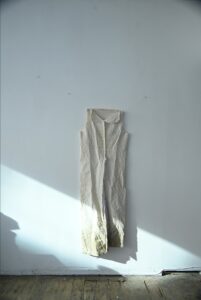
Adrian Piper: A Synthesis of Intuitions,

This sprawling Adrian Piper retrospective offers an eye-catching challenge to visitors through its sometimes demure, sometimes hectoring, text-and-photo and performance art. Sticking with it pays off with a reflective, ethical and political pow.
Piper was born in New York in 1948 and went with the counter-cultural flow of figurative psychedelia, changed to a somewhat purist Minimalism and Conceptualism before turning to explicit investigations of race, gender, and social responsibility for which she is best known. A dark-toned black and white photo series of self-portraits, Food for Spirit (1971), wherein while holding the camera barely, her mostly nude body emerges from the background, compels not only in terms of self-presentation but also her sustained interest in Kant’s writings on self-consciousness. Her personal experience with grey-scale in more ways than one is addressed in many works on paper, including the drawing, Self-Portrait Exaggerating My Negroid Features (1981), and fleshed out fully in Cornered (1988), a video piece which highlights the blind-spot racist assumptions of white society when it comes to skin color.
Piper’s street performances in gender-bending disguises (mainly 1970s), represented by collages and absurdist adverts placed in the classified section of art journals, harken back to the disruptive art antics of the Situationist International group. Looping footage of her now legendary Funk Lessons dance project (1983-84) at Berkeley, along with a follow-up, three decades later in Berlin, Germany (where she currently resides), even out her confrontational impulse and pun on her intense need to teach. Among other works I would recommend: Vanilla Nightmares (mid-1980s) a ghostly series of charcoals on newsprint that visualize the colonial degradation of Africans; video booth installations that contrast official violence with official news coverage; and a tough take-away poster piece on the 2012 murder of Florida youth, Trayvon Martin
Adrian Piper: A Synthesis of Intuitions, 1965-2016”March 27 – July 22, 2018 Museum of Modern Art, New York (Traveling to the Hammer Museum, UCLA, October 7, 2018 – January 16, 2019)
Jody B Cutler
Volume 32 no 6 July/August 2018 p 27


Hi Jody, though I really enjoyed your well written review, I had a thought and question for you. Is the interest in the art world less focused on what is happening in the mainstream scene such as places like the MOMA and other traditional art spaces, and is it becoming more focused on what is happening at the level of community and less “in the box”? Are we beginning to look at established museums as they really are? Static and hopelessly outdated?
Wow, that is a tough one! In short, yes and no. Unfortunately, I don’t think smaller/less publicized venues are really doing as well with the general public as it may seem from the (rightful) attention of cognoscenti, just because they are usually less accessible (hours/locations, etc.), overall. And I do think many museums are responding, including the MoMA, because, as you say, the idea of their status as outdated (and I’ll say:) elitist, and even covertly (if not overtly) racist, just could not sustain cultural competition at the juncture in postcolonial global time. Let’s see if anyone else joins in — I’ve got a few more ideas I’ll get back to!